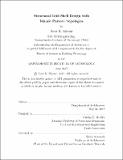| dc.contributor.advisor | Caitlin T. Mueller. | en_US |
| dc.contributor.author | Khouri, Noor K | en_US |
| dc.contributor.other | Massachusetts Institute of Technology. Department of Architecture. | en_US |
| dc.date.accessioned | 2017-09-15T14:22:49Z | |
| dc.date.available | 2017-09-15T14:22:49Z | |
| dc.date.copyright | 2017 | en_US |
| dc.date.issued | 2017 | en_US |
| dc.identifier.uri | http://hdl.handle.net/1721.1/111282 | |
| dc.description | Thesis: S.M. in Building Technology, Massachusetts Institute of Technology, Department of Architecture, 2017. | en_US |
| dc.description | This electronic version was submitted by the student author. The certified thesis is available in the Institute Archives and Special Collections. | en_US |
| dc.description | Cataloged from student-submitted PDF version of thesis. | en_US |
| dc.description | Includes bibliographical references (pages 81-84). | en_US |
| dc.description.abstract | Geometric patterns, pioneered centuries ago as a dominant form of ornamentation in Islamic architecture, represent an abundant source of possible topologies and geometries that can be explored in the preliminary design of discrete structures. This diverse design space motivates the coupling between Islamic patterns and the form finding of funicular grid shells for which structural performance is highly affected by topology and geometry. This thesis examines one such pattern through a parametric, performance-driven framework in the context of conceptual design, when many alternatives are being considered. Form finding is conducted via the force density method, which is augmented with the addition of a force density optimization loop to enable grid shell height selection. A further modification allows for force densities to be scaled according to the initial member lengths, introducing sensitivity to pattern geometry in the final form-found structures. The results attest to the viable synergy between architectural and structural objectives through grid shells that perform as well as, or better than, quadrilateral grid shells. Historic and cultural patterns therefore present design opportunities that both expand the conventional grid shell design vocabulary and offer designers an alternative means of referencing vernacular traditions in the modern built environment, through a structural engineering lens. Key words: grid shell, structural topology, Islamic pattern, parametric design, performance driven design, force density method, form finding. | en_US |
| dc.description.statementofresponsibility | by Noor K. Khouri. | en_US |
| dc.format.extent | 84 pages | en_US |
| dc.language.iso | eng | en_US |
| dc.publisher | Massachusetts Institute of Technology | en_US |
| dc.rights | MIT theses are protected by copyright. They may be viewed, downloaded, or printed from this source but further reproduction or distribution in any format is prohibited without written permission. | en_US |
| dc.rights.uri | http://dspace.mit.edu/handle/1721.1/7582 | en_US |
| dc.subject | Architecture. | en_US |
| dc.title | Structural grid shell design with Islamic pattern topologies | en_US |
| dc.type | Thesis | en_US |
| dc.description.degree | S.M. in Building Technology | en_US |
| dc.contributor.department | Massachusetts Institute of Technology. Department of Architecture | |
| dc.identifier.oclc | 1003490449 | en_US |
